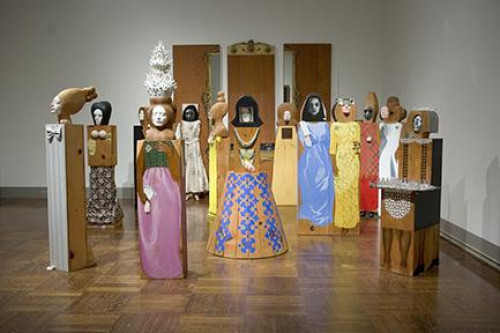Celebrate an influential and overlooked Pop art icon with “Marisol: A Retrospective,” on view March 2-June 2, 2024 at the Toledo Museum of Art (TMA). The career-spanning exhibition chronicles the artist’s full creative arc with 244 works, including objects from TMA’s collection. Her sculptures, self-portraits, sketches, source materials, studies and personal photographs take viewers through the artist’s evolving ideas and inspirations as she explored the cultural issues of her time, from social identities to the environment.
“Marisol is an important artist in the Toledo Museum of Art’s collection. ‘The Party’ is both one of her most significant works as well as a centerpiece of our 20th century collection,” said Adam Levine, TMA’s Edward Drummond and Florence Scott Libbey director and CEO. “It was natural that we would participate in this landmark exhibition and offer our audience deeper insights into Marisol’s practice, influence and impact. It’s a thought-provoking look into decades of her art practice and her place in the canon.”
Marisol was born in Paris; split her childhood between Caracas, New York and Los Angeles, studying at the Otis Art Institute and Jepson Art Institute in the latter; and attended the Académie Julian and École des Beaux-Arts in Paris before settling in New York in the 1950s and studying with Hans Hoffman.
Abstract Expressionism and pre-Columbian art inspired her early work. She incorporated discarded objects she found in New York City’s streets and would often cast her own face as well as other body parts in her sculptures. “Once I immerse myself in the material, it takes on a life of its own—one that’s very real,” Marisol said in a 1989 interview.
“The Party” (1965-66), an installation of 15 wooden sculptures in the Toledo Museum of Art collection, depicts guests at “a very elegant ball,” in Marisol’s words. Each character conveys an archetype, from the butler to the society lady, while bearing Marisol’s face. On its surface, it’s just a fun bash, but upon closer inspection a viewer might sense each guest’s isolation beneath the glamour even in this large convening.
“Baby Girl” (1963), also on view in the exhibition, addresses the role of women in society as well as the artist’s personal reflections on childhood. The dynamics of the nuclear family were a larger concern in Marisol’s work than mass media and culture, something that differentiated her from Pop art peers like Andy Warhol. Marisol addresses political and ecological concerns with “The Fishman” (1973). The standing wood sculpture emphasizes connections between life on land and sea life with a human’s body topped with the head of a fish.
“This exhibition demonstrates Marisol’s profound engagement with the world around her and her own profound impact on the broader social and cultural landscapes,” said Jessica S. Hong, TMA’s senior curator of modern and contemporary art. “She was an artist with verve and acuity, which she used as tools to challenge our ideas around gender, identity and societal standing, which continues their relevance in our lives today.”
Marisol’s first show at New York’s Sidney Janis Gallery in 1966 drew daily queues and her work appeared on the cover of Time magazine. She was also included in two Andy Warhol films. After achieving a taste of fame in New York in the 1960s, with her fill of gallery exhibitions and party invitations, Marisol left behind the constraints of fame to travel or live abroad for extended periods of time. Though she continued to work, her visibility waned.
“Writing and scholarship around Marisol have been limited. This exhibition provides more nuanced, complex understandings of her practice,” said Hong. “The Toledo Museum of Art has and continues to be committed to foregrounding underrecognized artists and sharing new insights into their life and work."
A fully illustrated catalogue will further explore Marisol’s life and work with never-before-seen archival images and new essays about her life and art. Hong is among the contributors.
“Marisol: A Retrospective” is organized by the Buffalo AKG Art Museum and curated by Cathleen Chaffee, Buffalo AKG’s Charles Balbach chief curator. The exhibition and catalogue are supported by a major grant from the Henry Luce Foundation. Critical work related to this exhibition and collection was made possible in part by a major grant from the National Endowment for the Humanities.
